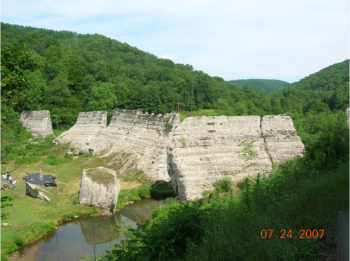Sliding Stability: Difference between revisions
No edit summary |
No edit summary |
||
| Line 10: | Line 10: | ||
<!-- Introductory paragraph or topic page summary --> | <!-- Introductory paragraph or topic page summary --> | ||
" | "[[Stability]] must be assessed on selected surfaces within the structure... Sliding safety must also be assessed at/or near the foundation-structure interface. This surface may be either level or sloping. Generally, it may by assumed that a surface that slopes upward (in the direction of possible sliding) will have a beneficial effect, while one that slopes downward will increase the possibility for sliding... Where a shallow weak seam exists below a structure's contact with the foundation, or a structure is imbedded below the top of the foundation, two possible failure modes are present. One mode involves slippage along the weak plane directly under the structure plus slippage along a plane through the foundation above the weak seam (crossbed shear for rock or passive resistance for soil). When the weak seam extends a large distance past the toe of the structure without daylighting, the second mode will usually be critical."<ref name="EM 1110-2-2100">[[Stability Analysis of Concrete Structures (EM 1110-2-2100) | Stability Analysis of Concrete Structures (EM 1110-2-2100), USACE, 2005]]</ref> | ||
==Examples== | ==Examples== | ||
Revision as of 17:02, 14 December 2022

|
| Learn from the failure of Bayless Dam due to instability at DamFailures.org |
"Stability must be assessed on selected surfaces within the structure... Sliding safety must also be assessed at/or near the foundation-structure interface. This surface may be either level or sloping. Generally, it may by assumed that a surface that slopes upward (in the direction of possible sliding) will have a beneficial effect, while one that slopes downward will increase the possibility for sliding... Where a shallow weak seam exists below a structure's contact with the foundation, or a structure is imbedded below the top of the foundation, two possible failure modes are present. One mode involves slippage along the weak plane directly under the structure plus slippage along a plane through the foundation above the weak seam (crossbed shear for rock or passive resistance for soil). When the weak seam extends a large distance past the toe of the structure without daylighting, the second mode will usually be critical."[1]
Examples
![]() Learn from the failure of Bayless Dam due to instability (DamFailures.org)
Learn from the failure of Bayless Dam due to instability (DamFailures.org)
Best Practices Resources
![]() Stability Analysis of Concrete Structures (EM 1110-2-2100) (U.S. Army Corps of Engineers)
Stability Analysis of Concrete Structures (EM 1110-2-2100) (U.S. Army Corps of Engineers)
![]() Sliding Stability for Concrete Structures (ETL 1110-2-256) (U.S. Army Corps of Engineers)
Sliding Stability for Concrete Structures (ETL 1110-2-256) (U.S. Army Corps of Engineers)
![]() Gravity Dam Design (EM 1110-2-2200), USACE, 1995
Gravity Dam Design (EM 1110-2-2200), USACE, 1995
![]() Design of Small Dams, USBR, 1987
Design of Small Dams, USBR, 1987
Trainings
![]() On-Demand Webinar: Stability Evaluations of Concrete Dams
On-Demand Webinar: Stability Evaluations of Concrete Dams
![]() On-Demand Webinar: Introduction to Concrete Gravity Dams
On-Demand Webinar: Introduction to Concrete Gravity Dams
Citations:
Revision ID: 5674
Revision Date: 12/14/2022
